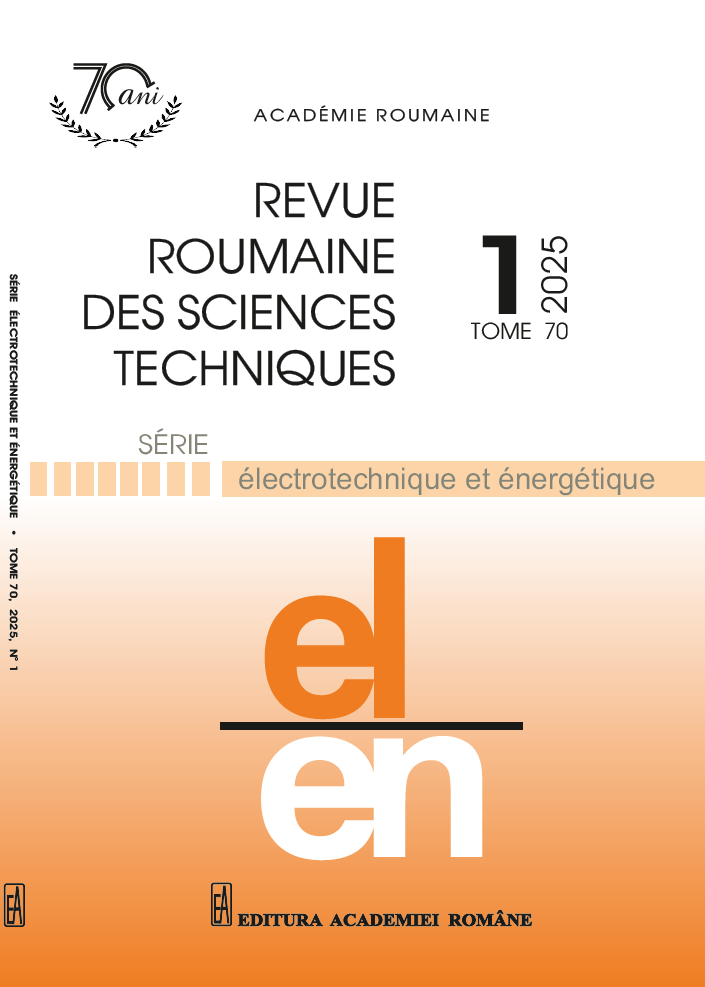MODÈLE ÉNERGÉTIQUE D'UN SYSTÈME DE COMPRESSION DE GAZ À PISTON LIQUIDE
DOI :
https://doi.org/10.59277/RRST-EE.2025.1.25Mots-clés :
Stockage d'énergie par air comprimé, Piston liquide, Système Hamiltonien de port, Graphique de liaison, Accumulateur hydropneumatique, Modèle basé sur l'énergieRésumé
Les systèmes de stockage d'énergie par air comprimé (CAES) sont utilisés dans les systèmes d'énergie renouvelable autonomes ou semi-autonomes en raison de leurs avantages par rapport au stockage d'énergie par batterie, notamment un processus de production respectueux de l'environnement et un nombre de cycles suffisamment important. La technologie à piston liquide (LP) pour le CAES constitue une alternative aux autres technologies de compression de gaz développées pour améliorer le transfert de chaleur et ainsi accroître l'efficacité énergétique. Un modèle énergétique d'accumulateur hydropneumatique utilisant la compression de gaz LP sous forme hamiltonienne (pH) est développé pour la conception du contrôle. Le cadre du bond graph est utilisé pour dériver directement les équations sous forme de pH en exploitant la capacité non linéaire du fluide comme modèle de stockage. La non-linéarité est représentée analytiquement pour un processus polytropique généralisé prenant en compte les conditions de gaz idéal. Le fonctionnement du modèle développé est validé par des simulations Simscape sous MATLAB R2021b.
Références
R. A. Rabi, J. Radulovic, J. Buick, Comprehensive review of com-pressed air energy storage (CAES) technologies, Thermo, 3, 1, pp. 104–126 (2023).
H. Guo, H. Kang, Y. Xu, M. Zhao, Y. Zhu, H. Zhang, H. Chen, Review of coupling methods of compressed air energy storage systems and renewable energy resources, Energies, 16, 12, 4667 (2023).
E. Bazdar, F. Nasiri, F. Haghighat, Optimal planning and configuration of adiabatic-compressed air energy storage for urban buildings application: Techno-economic and environmental assessment, J. Energy Storage, 76, 109720 (2024).
H. Tian, H. Zhang, Z. Yin, Y. Liu, X. Zhang, Y. Xu, H. Chen, Advancements in compressed air engine technology and power system integration: A comprehensive review, Energy Rev., 2, 4, 100050 (2023).
J. D. van de Ven, P. Y. Li, Liquid piston gas compression, Appl. Energy, 86, 10, pp. 2183–2191 (2009).
R. Lemofouet, A. Rufer, A hybrid energy storage system based on compressed air and supercapacitors with maximum efficiency point tracking (MEPT), IEEE Trans. Ind. Electron., 53, 4, pp. 1105–1115 (2006).
E. M. Gouda, Y. Fan, M. Benaouicha, T. Neu, L. Luo, Review on liquid piston technology for compressed air energy storage, Sci. World J., 2014, 289839 (2014).
M. Saadat, P. Y. Li, T. W. Simon, Optimal trajectories for a liquid piston compressor/expander in a compressed air energy storage system with consideration of heat transfer and friction, 2012 Am. Control Conf. (ACC), pp. 1800–1805 (2012).
S. Ma, X. Wang, M. Negnevitsky, E. Franklin, Performance investi¬gation of a wave-driven compressed air energy storage system, J. Energy Storage, 73, 109126 (2023).
P. J. Gawthorp, G. P. Bevant, Bond-graph modeling, IEEE Control Syst., 27, 2, pp. 24–45 (2007).
W. Borutzky, Bond graph modelling and simulation of multi-disciplinary systems – An introduction, Simul. Model. Pract. Theory, 17, 1, pp. 3–21 (2009).
A. van der Schaft, Port-Hamiltonian modeling for control, Annu. Rev. Control Robot. Auton. Syst., 3, 1, pp.393–416 (2020).
S. Mahdab, A. Moualdia, Intelligent management of a hybrid system by fuzzy logic: application to arc welding, Rev. Roum. Sci. Techn. – Électrotechn. et Énerg., 67, 2, pp. 111–116 (2022).
Widjonarko, S. R. Soenoko, S. Wahyudi, E. Siswanto, Design of air motor speed control system for small scale compressed air energy storage using fuzzy logic, IOP Conf. Ser.: Mater. Sci. Eng., 494, 012025 (2019).
Y. Oubbati, B. K. Oubbati, A. Rabhi, S. Arif, Experimental analysis of hybrid energy storage system based on nonlinear control strategy, Rev. Roum. Sci. Techn. – Électrotechn. et Énerg., 68, 1, pp. 96–101 (2023).
G. Tu, Y. Li, J. Xiang, Sliding mode control of energy storage systems for reshaping the accelerating power of synchronous generators, IEEE Trans. Power Syst., 38, 2, pp. 1242–1256 (2023).
K. Venugopalan, J. Varghese, J. Thankaswamy, African vulture opti¬mized integrated control technique for PV-fed open-end winding induction motor pump application, Rev. Roum. Sci. Techn. – Électrotechn. et Énerg., 69, 1, pp. 27–32 (2024).
X. Huang, R. Hao, L. Zhang, H. Sun, Q. Zheng, System modeling and compression efficiency optimal control of hydro-pneumatic cycling compressed air energy storage system, Zhongguo Dianji Gongcheng Xuebao/Proc. Chin. Soc. Electr. Eng., 34, 13, pp. 2047–2054 (2014).
J. Bai, W. Wei, S. Mei, Optimal charging power tracking control of advanced adiabatic compressed air energy storage over wide operation ranges, 2022 6th Int. Conf. Smart Grid Smart Cities (ICSGSC): 24–32, Chengdu, China (2022).
R. Ortega, A. J. van der Schaft, I. Mareels, B. Maschke, Putting energy back in control, IEEE Control Syst. Mag., 21, 2, pp. 118–33 (2001).
B. T. Kulakowski, F. Gardner, J. L. Shearer, Dynamic Modeling and Control of Engineering Systems (3rd ed.), Cambridge University Press, pp. 219–224 (2007).
A. Rufer, Energy Storage: Systems and Components (1st ed.), CRC Press, pp.151–160 (2017).
R. Ramakrishnan, S. S. Hiremath, M. Singaperumal, Dynamic analysis and design optimization of series hydraulic hybrid system through power bond graph approach, Int. J. Vehicular Technol., 2014, pp. 1–19 (2014).
Y. Li, Z. Zhu, G. Chen, Bond graph modeling and validation of an energy regenerative system for emulsion pump tests, Sci. World J., 2014, 289839 (2014).
A. van der Schaft, Geometric modeling for control of thermodynamic systems, Entropy, 25, 4, 577 (2023).
H. Ramirez, Y. le Gorrec, An overview on irreversible port-Hamil¬tonian systems, Entropy, 24, 10, 1478 (2022).
Téléchargements
Publiée
Numéro
Rubrique
Licence
(c) Copyright REVUE ROUMAINE DES SCIENCES TECHNIQUES — SÉRIE ÉLECTROTECHNIQUE ET ÉNERGÉTIQUE 2025

Ce travail est disponible sous licence Creative Commons Attribution - Pas d'Utilisation Commerciale - Pas de Modification 4.0 International.


